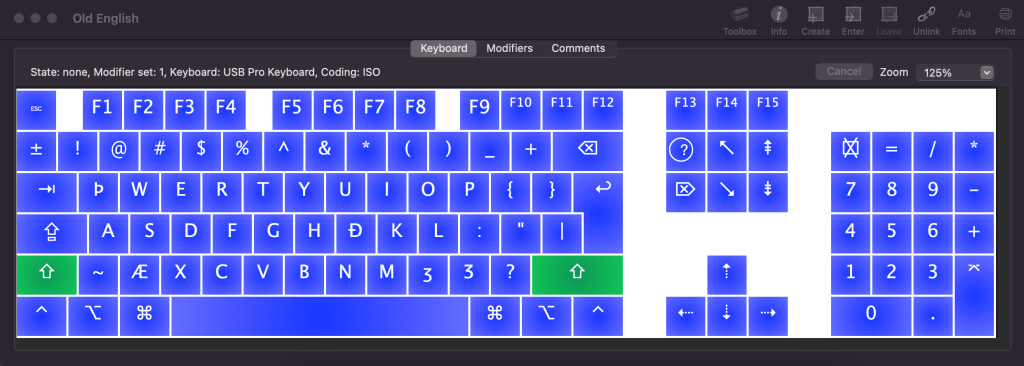I have a poem guide for this Middle English alliterative poem as well as a translation into Present-Day English, both up at Poetry Foundation.
Middle English keyboard
I have defined a custom input source (aka keyboard layout) for Mac OS to enable me to type the premodern English characters ash (æ, Æ), eth (ð, Ð), thorn (þ, Þ), and yogh (ʒ, Ʒ). This is essential for my research, as otherwise I would have to copy and paste each character each time I type a block quotation or produce an edition of a poem. Now that I’ve gotten used to the custom keyboard I can type Middle English as fast as I type Present-Day English.

I defined the keyboard using the following substitutions: ash mapped onto z, eth mapped onto j, thorn mapped onto q, and yogh mapped onto < (lowercase) and > (uppercase). (The letters j, q, and z are rare in Old and Middle English.) If I had it to do again I might have mapped yogh onto x, also rare in Old and Middle English; but I am too used to the layout to want to change it now. I previously replaced v, which is not used in Old English, with wynn (ƿ, Ƿ). As I work more in Middle English than Old English these days, and wynn went defunct before the Middle English centuries, while v was used in more words, it is more important for me to have v available within the custom keyboard.
Here is the latest version of my keyboard layout in .keylayout format for anyone to use. Maybe this will be helpful to the medievalist readers. If you’d like to modify it at all, I recommend the program Ukelele.
To install on a Mac, copy the file into Library > Keyboard Layouts or create this subfolder. Then activate the layout by visiting System Settings > Keyboard > Text Input > Input Sources > Edit > “+.” The custom layout should appear under Others with the name Old English. It is then a simple matter of defining a keyboard shortcut to toggle between the regular layout and the Early English one. I use command + spacebar, which is convenient.
alliterative verse / avant-garde
I have a new curated collection of poems, premodern and contemporary, up at Poetry Foundation. Come for the Anne Carson; stay for the Piers Plowman. This was a lot of fun to pull together. It is inspired by my current book project, which likewise juxtaposes premodern and avant-garde contemporary poetry, but there are many poems in the collection not discussed in the book (and vice versa).
From the introduction:
So many of the poems brought together here, premodern and contemporary, travel that circuit between paying rent and creating art: the demands of the aesthetic economy balanced uneasily against the demands of the economy-economy. The 20th- and 21st-century poems in this collection broach a transtemporal communication through which readers can receive “a modern letter sent from antiquity” (Willis, “Tiptoe Lightning”). Certain time-bending passages in St. Erkenwald and other alliterative poems anticipate the linkage, as if these distant poems were expecting us all along.

video interview
There is a new video up at abitlit.co featuring Andy Kesson’s interview with me about my new book.
virtual exhibits
My second monograph, Meter and Modernity in English Verse, 1350-1650, currently appears in three virtual conference exhibits, each carrying a discount code for 40% off:
- Shakespeare Association of America (code SHAKES40-FM)
- Renaissance Society of America (code RSA40-FM)
- Medieval Academy of America (code MAA40-FM)
Some highlights of the book: it’s organized by metrical history rather than clock time; Lord Byron flits in and out of the book; new readings of Langland and Chaucer and their sixteenth- and seventeenth-century reception; a sociopolitical argument about the formation of an “English literary tradition”; George Gascoigne is an unexpected star; some of the first readings of the metrical forms of English political prophecy.
You must be logged in to post a comment.